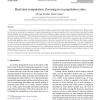Free Online Productivity Tools
i2Speak
i2Symbol
i2OCR
iTex2Img
iWeb2Print
iWeb2Shot
i2Type
iPdf2Split
iPdf2Merge
i2Bopomofo
i2Arabic
i2Style
i2Image
i2PDF
iLatex2Rtf
Sci2ools
BIOSYSTEMS
2007
2007
Real time computation: Zooming in on population codes
Information processing in nervous systems intricately combines computation at the neuronal and network levels. Many computations may be envisioned as sequences of signal processing steps along some pathway. How can information encoded by single cells be mapped onto network population codes, and how do different modules or layers in the computation synchronize their communication and computation? These fundamental questions are particularly severe when dealing with real time streams of inputs. Here we study this problem within the context of a minimal signal perception task. In particular, we encode neuronal information by externally applying a space- and time-localized stimulus to individual neurons within a network. We show that a pulse-coupled recurrent neural network can successfully handle this task in real time, and obeys three key requirements: (i) stimulus dependence, (ii) initial-conditions independence, and (iii) accessibility by a readout mechanism. In particular, we suggest...
| Added | 08 Dec 2010 |
| Updated | 08 Dec 2010 |
| Type | Journal |
| Year | 2007 |
| Where | BIOSYSTEMS |
| Authors | Olivier Rochel, Netta Cohen |
Comments (0)

